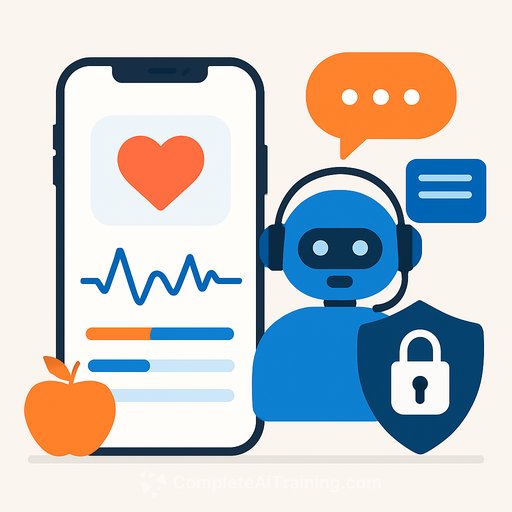Now is Iowa's moment to use AI to improve health care
AI in healthcare should mean one thing: more time with patients. Less clicking, fewer delays, and care that feels personal again. If Iowa moves with intent, we can reduce burnout, improve outcomes, and give patients more control over their health.
What AI can fix this year
- Documentation: Ambient scribe tools that draft notes from the visit so clinicians review and sign instead of typing all night.
- Triage and routing: Smart intake that tags urgency, flags red flags, and routes messages to the right role the first time.
- Scheduling and access: Predict no-shows, suggest overbook windows, and match patients to the right appointment length.
- Prior authorization: Auto-fill forms, attach required evidence, and monitor status so staff handle exceptions, not paperwork.
- Imaging and diagnostics support: Assistance that highlights potential findings and ensures no obvious detail is missed, with final decisions kept by clinicians.
- Care coordination: Close the loop on referrals, surface gaps in care, and keep everyone aligned across settings-critical for rural hospitals and clinics.
A practical rollout plan
- Phase 1: Quick wins (30-90 days)
- Deploy ambient documentation in high-burden clinics (primary care, ED, behavioral health).
- Launch message triage for patient portals and nurse lines.
- Automate prior auth prep for top 10 procedures or meds by volume.
- Phase 2: Scale and integrate (90-180 days)
- Risk stratification for chronic conditions (diabetes, CHF, COPD) tied to care management workflows.
- Referral management that guides to in-network, shortest wait, and best fit.
- Imaging assistance in high-volume areas like chest X-ray and MSK, with strict oversight and QA.
- Phase 3: System-level gains (6-12 months)
- Population health insights that feed value-based care contracts.
- Clinical co-pilots that draft prior-visit summaries, orders, and follow-up plans for clinician review.
- Community health links that surface social needs and local resources.
Guardrails that keep patients safe and clinicians in control
- Human in the loop: AI drafts; clinicians decide. Document the oversight steps.
- Transparency: Patients and staff know when AI is used and what it does-and doesn't do.
- Bias checks: Monitor outcomes by race, gender, age, disability, and geography. Adjust models and workflows if gaps appear.
- Fallbacks: Clear paths to manual review when confidence is low or data is incomplete.
- Security and privacy: Limit PHI exposure, encrypt data, and keep a detailed audit trail. Ensure Business Associate Agreements cover model training and retention.
- Regulatory readiness: Distinguish workflow assist tools from Software as a Medical Device. Track applicable guidance and labeling.
For risk management and governance, use frameworks that healthcare teams already trust. The NIST AI Risk Management Framework is a solid anchor for policy, testing, and continuous monitoring. See the NIST AI RMF.
If you deploy AI that functions like a medical device, review current FDA expectations and documentation needs early. FDA resources are here.
Build an Iowa coalition
AI works best with clean data and shared standards. This is where Iowa can lead by working as one system.
- Strengthen the HIE: Standardize data feeds, reduce duplicate records, and agree on core fields needed for AI use cases.
- TEFCA alignment: Connect rural and urban systems with national exchange to improve continuity of care for patients who cross networks. Learn about TEFCA.
- Public-private pilots: Pair Medicaid, FQHCs, and critical access hospitals with health systems and universities to test solutions where access gaps are widest.
- Shared procurement: Vet vendors once, share evaluation results, and negotiate fair pricing for smaller clinics.
What to start this quarter
- Pick three use cases with clear ROI: documentation, message triage, prior auth.
- Set up governance: one clinical lead, one data/privacy lead, one operations lead, one patient advocate.
- Define success upfront: minutes saved per visit, documentation accuracy, staff overtime, patient response times, and safety events.
- Run two pilots for 8-12 weeks with small, motivated teams. Compare to baseline and expand only if targets are met.
- Update policies: AI use, model validation, disclosure language, and incident response.
- Train and support: short sessions, office hours, and easy playbooks embedded in the EHR.
Clinical workflow rules that make or break adoption
- Put the AI where work already happens-inside the EHR, inbox, or imaging viewer.
- Default to "draft and review," never auto-commit clinical content.
- Show the source: highlight audio segments, citations, or image regions that informed the output.
- Make it easy to correct the AI and learn from feedback.
- Track burden weekly and share the numbers with staff-nothing builds trust like seeing time given back.
Rural focus, real gains
AI can lighten the load where staffing is thin and access is limited. Start with tools that reduce after-hours work and speed up patient communication. Pair that with telehealth, language services, and transportation support to make the technology count.
For imaging, consider regional reading hubs with AI-assisted triage so local teams get faster reads without losing oversight. For chronic care, use risk signals to target nurse outreach, pharmacy reviews, and community resources.
Skills and support for your team
Upskill clinicians and staff with short, practical sessions: how the tool works, what to double-check, and how to give feedback. Keep it hands-on. Give super-users time to coach peers and close the loop on issues quickly.
If you need structured upskilling by role, see this catalog of practical programs: AI courses by job.
The outcome that matters
This isn't about flashy tech. It's about fewer clicks, faster answers, and conversations that patients remember. Iowa can set a standard: safer care, time back for clinicians, and patients who feel seen. Start small, measure honestly, and scale what works.
Your membership also unlocks:






